When the sun won't cooperate, you've got plenty of reliable cooking alternatives. Rocket stoves offer portable, efficient cooking using wood or charcoal with up to 22,000 BTU output. Indoor electric options like smokeless grills and crockpots keep meals on track, while gas-powered combination ovens deliver precise temperature control. Wood-burning stoves and multi-fuel systems provide sustainable heating with up to 80% efficiency. For DIY solutions, try tea light slow cookers, hay box ovens, or reflector ovens. Induction cooktops, emergency thermal cookers, and traditional fire pit methods round out your cloudy-day arsenal. These proven methods guarantee you'll never go hungry when solar cooking isn't an option.
Rocket Stoves for Quick Meals
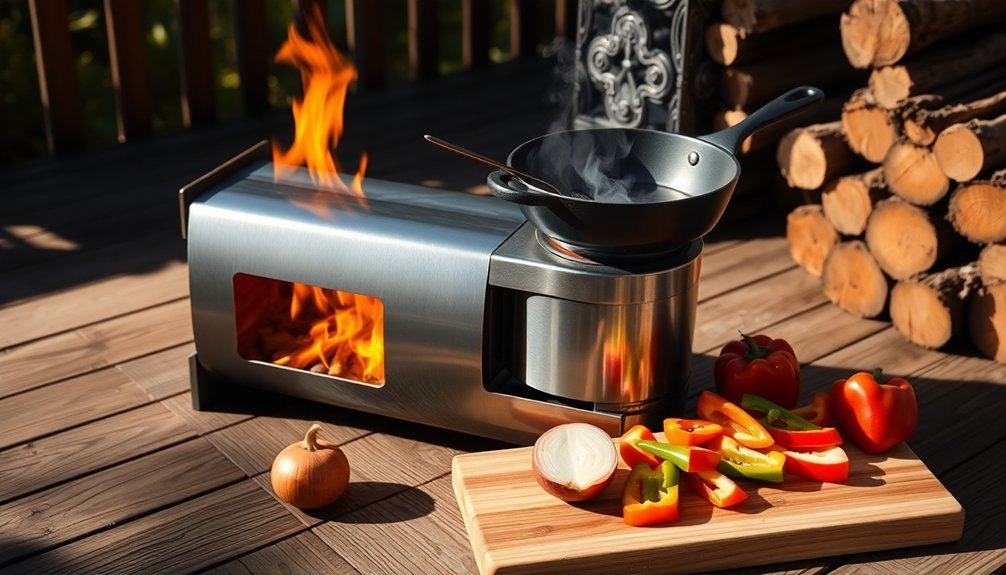
When you need a reliable cooking solution during cloudy days or emergencies, rocket stoves offer an efficient and versatile option. Built from durable stainless steel or cast iron, these stoves concentrate flames for maximum heat output while conserving fuel. With 22,000 BTU output, these stoves deliver powerful cooking performance.
You'll find rocket stoves incredibly easy to use. Just start with a wadded paper sheet and small twigs, and you'll have cooking-ready heat within 5 minutes. You can burn wood, charcoal, or biomass fuel, making them adaptable to various environments.
They'll accommodate any cookware, from frying pans to griddle tops, perfect for whipping up breakfast items, fajitas, or grilled dishes.
Their portability and minimal maintenance needs make them ideal for camping trips or emergency situations. You won't need complex setup procedures – just light, cook, and clean with minimal effort.
Indoor Electric Cooking Options
While outdoor cooking methods provide flexibility, indoor electric cooking options offer reliable alternatives during cloudy weather.
You'll find smokeless electric grills, like the Zojirushi and Hamilton Beach models, perfect for searing steaks and grilling vegetables with minimal smoke production. Just watch out for fatty foods and sugary marinades that can increase smoke. Adequate ventilation is essential when using any indoor cooking appliance.
You can power these appliances using solar generators during outages, though you'll need to plan carefully.
Crock pots and rice cookers use 200-300 watts, while microwaves demand around 1,200 watts. For a more efficient option, consider thermal cookers, which continue cooking after you've removed the heat source.
They're ideal for soups and stews, and you won't waste precious fuel or heat up your house unnecessarily.
Gas-Powered Kitchen Solutions
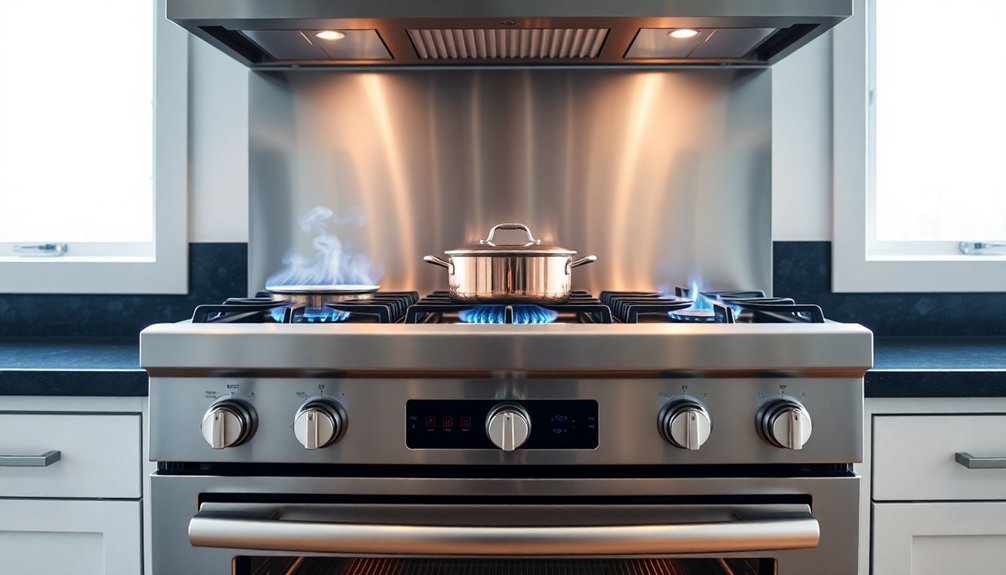
Despite cloudy weather limiting solar options, gas-powered kitchen solutions offer reliable and efficient cooking alternatives.
You'll find versatile equipment like gas combination ovens that deliver both steam and convection cooking modes, helping you save on space and costs while maintaining consistent results. These advanced control systems optimize precision cooking across multiple functions and recipes.
For precise temperature control, you can rely on convection ovens with Dual Flow™ systems that efficiently circulate heated air through dual blower wheels.
If you're looking to grill, MagiKitch'n charbroilers come in multiple sizes and can be converted between radiant and coal-style cooking.
To guarantee peak performance, you'll need proper gas supply matching your equipment's BTU ratings.
Consider using Dormont Blue Hose™ kits for safe installation of movable equipment.
These gas-powered solutions provide instant heat and better energy efficiency than many alternatives.
Efficient Wood-Burning Cooking Methods
A well-maintained wood-burning stove offers remarkable cooking efficiency while providing sustainable heating for your home. You'll get excellent results by selecting the right wood types and maintaining your stove properly. Regular stove inspections help prevent potential safety hazards and maintain optimal performance.
| Wood Type | Cooking Benefits |
|---|---|
| Oak | Long-lasting heat, ideal for slow cooking |
| Ash | Quick to season, minimal smoke for clean cooking |
| Maple | Steady heat, perfect for consistent temperatures |
| Birch | Fast burning, adds flavor to grilled foods |
| Fir | Hot and long-lasting for low-slow recipes |
To maximize efficiency, keep your stove clean and place it centrally on the ground floor. You can achieve 80% efficiency with modern wood stoves compared to just 32% with open fires. Try combining different wood types for excellent heat control, and use cast iron cookware to retain heat effectively.
Induction Cooking Advantages
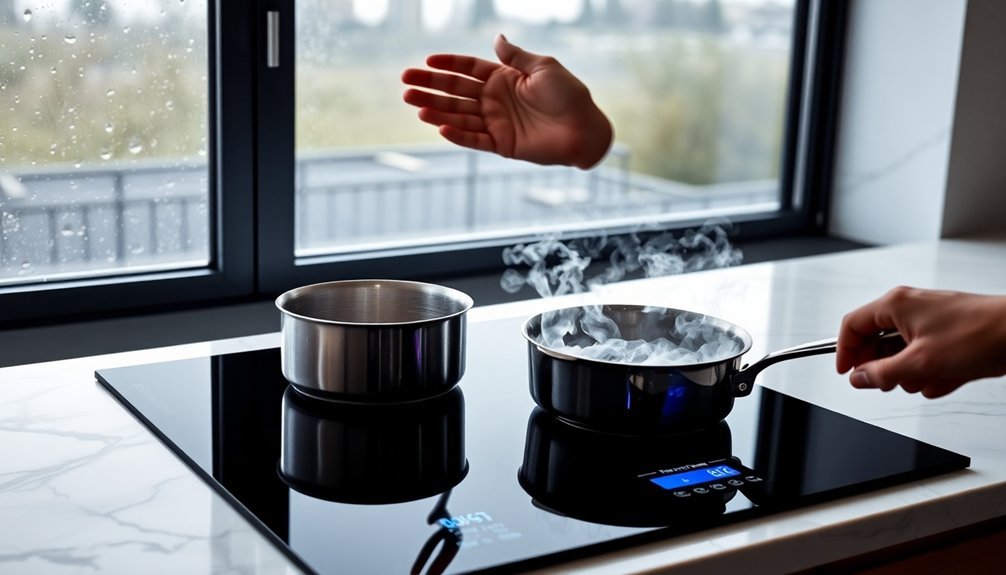
Your switch to induction cooking lets you boil water three times faster than gas while using 84% of the energy efficiently.
You'll appreciate the precise temperature control across 17 heat settings, making it easier to perfect everything from delicate sauces to high-heat searing.
The cooktop's surface stays cool while cooking, creating a cleaner, safer kitchen environment with less wasted heat affecting your space.
Speed Plus Energy Savings
When searching for efficient cooking alternatives, induction cooktops stand out for their impressive speed and energy-saving benefits. You'll boil water in half the time compared to gas or electric stoves, and you won't waste energy heating the surrounding air. Since the heat generates directly in your cookware, you'll cut overall cooking time by 25-50%.
| Feature | Benefit |
|---|---|
| Direct Heat | No wait time for surface warmup |
| Fast Boiling | Water boils in under 4 minutes |
| Energy Transfer | Heat goes straight to the pan |
| Cost Savings | Lower monthly utility bills |
The efficiency doesn't just save time – it'll reduce your energy bills and environmental impact. Since there's no wasted heat escaping into your kitchen, you'll keep your cooking space cooler while achieving faster results with less energy consumption.
Temperature Control Excellence
Modern induction cooking revolutionizes temperature control with precision that surpasses traditional stovetops. You'll get exact temperature settings between 77-482°F, with stability within 1°C, making it perfect for delicate tasks like melting butter or crafting complex sauces.
The system's advanced sensors monitor your pan's temperature 20 times per second, automatically adjusting heat to maintain your chosen setting. You can customize cooking preferences with technique-specific presets and control how quickly your cooktop reaches target temperatures.
Whether you're searing, braising, or poaching, you'll achieve consistent results every time.
For up to 72 hours, you can hold steady temperatures, allowing for extended cooking sessions. The color touchscreen makes it easy to manage settings and create custom presets for your favorite dishes.
Cleaner Kitchen Environment
Induction cooking's remarkable efficiency creates a noticeably cleaner kitchen environment in multiple ways.
You'll breathe easier knowing there aren't any toxic gases being released into your home, unlike with gas stoves. The cooktop's surface stays cool during cooking, which means food won't burn onto it and create stubborn, hard-to-clean messes.
You can simply wipe away spills and splatters with a quick swipe of a sponge, rather than scrubbing away at burnt-on residue. The smooth, crevice-free surface design makes cleaning even more straightforward.
Since there's less wasted heat radiating into your kitchen space, you'll enjoy a more comfortable cooking environment. Plus, your HVAC system won't have to work as hard to maintain your desired room temperature.
Portable Propane Stove Setup
Setting up your portable propane stove requires careful attention to burner valve positioning and secure fuel connections to guarantee safe operation.
You'll need to connect the regulator properly to both the stove and propane cylinder, keeping the tank upright and checking for potential leaks with a soap solution.
When transporting or storing your stove, always disconnect the fuel supply and let the unit cool completely before packing it away from any heat sources.
Safe Setup Guidelines
To guarantee safe operation of your portable propane stove, proper setup becomes the critical first step. You'll need to focus on both surface stability and fuel connections to ascertain safe cooking. Choose a flat, sturdy area away from flammable materials and make sure you're in a well-ventilated space.
- Position your stove on a level surface, extending all support arms until they lock firmly in place – imagine setting up a miniature cooking platform.
- Connect the gas line to both the stove and tank, checking for leaks with soapy water – like finding an air leak in a bicycle tire.
- Test the ignition in a controlled manner, adjusting the flame as needed – similar to fine-tuning a precision instrument.
- Keep your cooking pans sized appropriately for your stove, ascertaining proper airflow – think of a perfectly balanced cooking system.
Storage and Transport Tips
Since proper storage extends the life of your propane equipment, understanding safe storage and transport practices becomes crucial.
Store your tanks outdoors or in a well-ventilated, detached shed away from your home. Keep them upright on a sturdy surface like concrete or wood to prevent moisture damage.
You'll need to monitor temperature conditions carefully. Don't let your tanks get hotter than 120°F or colder than -40°F. Avoid direct sunlight and never store them in your car trunk or home.
When storing, make certain the valve is off and keep the area free of electrical tools and flammable materials.
Regularly check your tanks for damage or leaks, and maintain a dry storage environment to prevent rust.
Remember to store them uncovered or with proper ventilation, never in enclosed spaces.
Fuel Connection Steps
Properly connecting a propane stove starts with choosing a level, stable surface away from any flammable materials.
You'll need to verify you're in a well-ventilated area before proceeding with the fuel connection process.
- Connect your gas line firmly to both the stove and propane tank, making sure the fittings are snug but not overtightened.
- Mix one tablespoon of dish soap with a cup of water and apply this solution to all connection points – any bubbles indicate a leak.
- Double-check that your propane tank is securely fastened to the stove's coupling system.
- Test the connection by slowly turning on the gas valve while listening for any hissing sounds.
If you detect any leaks, immediately turn off the gas and reconnect the fittings before testing again.
Don't proceed with lighting until all connections are secure and leak-free.
DIY Emergency Cooking Alternatives
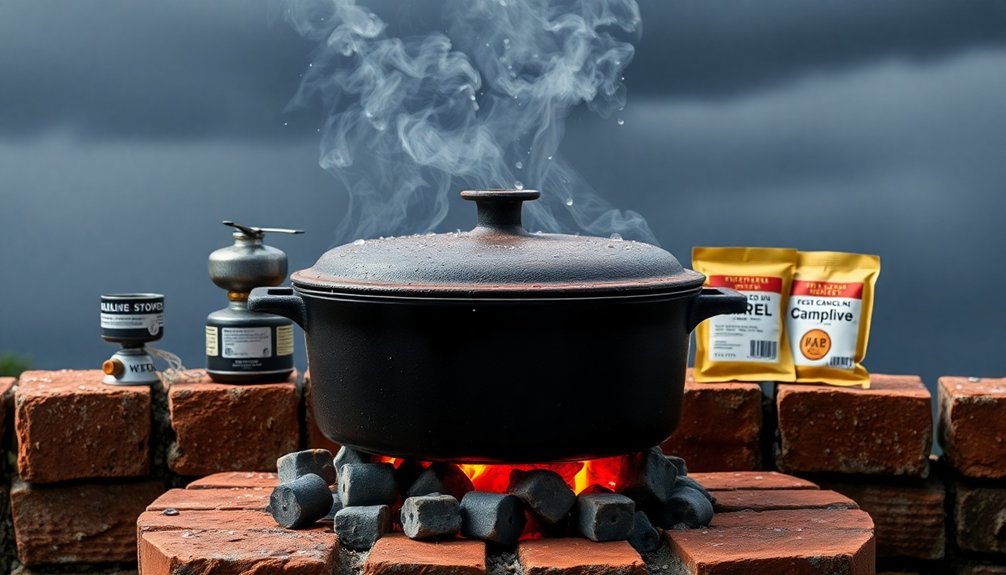
When power outages or emergencies strike, having reliable cooking alternatives can mean the difference between hot meals and cold rations.
You'll find several DIY options that don't require electricity or gas. A tea light slow cooker uses multiple candles to create steady heat for simmering food, while a hay box oven relies on insulation from hay or old sweaters to maintain cooking temperatures.
If you're comfortable with traditional methods, try an earth oven by digging a hole and lining it with hot stones – it's perfect for slow-cooking with steam from green branches.
For a portable solution, consider using canned heat or making a tuna can stove. Canned heat won't evaporate during storage, and a tuna can stove, made with oil and toilet paper, provides up to 25 minutes of cooking time.
Multi-Fuel Stove Systems
Multi-fuel stoves represent the pinnacle of versatile outdoor cooking, offering you remarkable flexibility in fuel choices and performance. You'll find these powerhouses can efficiently burn everything from wood pellets and corn to various liquid fuels, while delivering impressive heat output of up to 3000W.
- Picture yourself boiling water in just over three minutes using premium titanium construction.
- Imagine controlling precise flames from a gentle simmer to roaring heat.
- Visualize loading different fuels into the advanced feed system for up to 26 hours of burn time.
- Think about easily adjusting digital controls while watching the flames through ceramic glass windows.
With simple maintenance requirements and included cleaning tools, you'll spend more time cooking and less time servicing.
These stoves' durable construction and software-driven controls guarantee reliable performance when you need it most.
Energy-Saving Kitchen Equipment

Today's kitchen equipment offers remarkable energy-saving features that'll revolutionize your cooking while reducing utility costs.
You'll find cutting-edge options like Prodigi™ combination ovens that cook 80% faster than conventional units while using considerably less water and energy.
Consider induction cooktops that transfer 90% of heat directly to your cookware, keeping your kitchen cooler and your energy bills lower.
Multi-function ovens, like the 5-in-1 Advantium models, let you convection cook, toast, warm, proof, and microwave all in one unit. They'll cook your food up to four times faster than traditional ovens.
For specialized tasks, Energy Star certified equipment delivers impressive savings.
You'll cut costs with efficient fryers that save up to $4,500 over their lifetime, and steam cookers that reduce both energy and water usage by 60-90%.
Off-Grid Cooking Methods
When you can't rely on solar cooking during cloudy weather, you'll need dependable alternatives like propane stoves, wood-burning rocket stoves, and charcoal reflector ovens.
These portable heat sources let you cook efficiently off-grid while maintaining temperature control for various cooking methods.
You can also create DIY solutions like Dutch oven setups with fire pits or construct simple evaporative coolers to preserve food without electricity.
Fuel-Free Cooking Solutions
Living without conventional power doesn't mean you're limited to cold meals, thanks to several reliable off-grid cooking methods.
You'll find that biomass stoves, denatured alcohol stoves, and rocket stoves offer practical solutions that don't rely on sunshine like solar ovens do.
When choosing your cloudy-day cooking method, consider these fuel-efficient options:
- Pack an Instafire Inferno biomass stove that burns readily available materials like twigs and pinecones.
- Set up a compact Folding Camp Stove that runs quietly on denatured alcohol.
- Build or buy a rocket stove that can cook an entire meal with just a handful of twigs.
- Keep multiple stove types on hand to adapt to different situations and fuel availability.
Remember to maintain proper ventilation when using any of these methods indoors.
Portable Emergency Heat Sources
Whether you face a power outage or need to cook off-grid, portable emergency heat sources provide reliable alternatives to traditional kitchen appliances.
Butane stoves offer a safe indoor cooking solution with enough power to prepare complete meals, while portable propane cookers deliver versatility for outdoor use.
You'll find multi-fuel options like the Volcano Portable Stove particularly adaptable, as they work with charcoal, propane, or wood.
The stove's 17-inch diameter footprint makes it compact yet functional. For efficiency, consider rocket stoves that quickly burn wood through an insulated chimney system.
When selecting your backup cooking method, factor in fuel availability and storage requirements.
Store propane tanks outside and upright, and always maintain proper ventilation when using any fuel-burning appliance for cooking.
DIY Alternative Heat Methods
Despite relying on basic materials, DIY alternative cooking methods offer robust solutions for off-grid meal preparation.
You'll find that rocket stoves, made from loose bricks, can boil water in just 15 minutes while using minimal fuel. Wood-burning stoves provide versatility for baking and boiling, perfect for extended off-grid stays.
- A simple rocket stove channeling flames through its chimney, creating an efficient burn that heats your pot with minimal smoke.
- Cast iron pans sizzling over a carefully constructed fire pit, releasing aromatic wisps into the air.
- A Swedish Torch, split and burning from within, supporting your cookware on its natural platform.
- A reflector oven capturing and directing heat from an open fire, turning simple ingredients into hearty meals.
These DIY methods guarantee you're never without a way to prepare hot meals, regardless of weather conditions.
Frequently Asked Questions
How Do Different Cooking Methods Affect the Nutritional Value of Food?
You'll find that water-based cooking can reduce water-soluble vitamins, while dry heat methods like baking retain more nutrients. Stir-frying preserves vitamins well, but deep-frying considerably decreases nutritional value and adds calories.
Can Multiple Alternative Cooking Methods Be Safely Used in the Same Space?
You'll need proper ventilation and designated zones when using multiple cooking methods. Keep equipment separate, maintain safe distances between stations, and follow cross-contamination protocols to guarantee food safety in your workspace.
What Weather Conditions Besides Clouds Can Impact Alternative Cooking Methods?
You'll find that wind can destabilize cooking setups, rain makes fire-starting difficult, extreme temperatures affect fuel efficiency, and snow or ice can make cooking areas unsafe and slow down your cooking process.
Which Cooking Methods Are Best for Long-Term Food Storage Preparation?
You'll find canning, dehydrating, and freezing are your best methods for long-term food storage. They'll preserve nutrients while keeping food safe to eat. Choose canning for shelf-stable items and freezing for ready-made meals.
How Do Altitude Changes Affect the Performance of Different Cooking Methods?
You'll need to adjust your cooking methods at higher altitudes since water boils at lower temperatures. You'll face longer cooking times, faster rising in baked goods, and must reduce frying temperatures for proper results.
In Summary
You'll never have to worry about cloudy skies ruining your meal plans with these reliable cooking alternatives. Whether you're using a rocket stove, induction cooktop, or multi-fuel system, you've got plenty of options to keep your kitchen running smoothly. Remember to maintain your backup cooking equipment and keep necessary fuel sources on hand. That way, you'll stay prepared for any weather while enjoying hot, home-cooked meals.

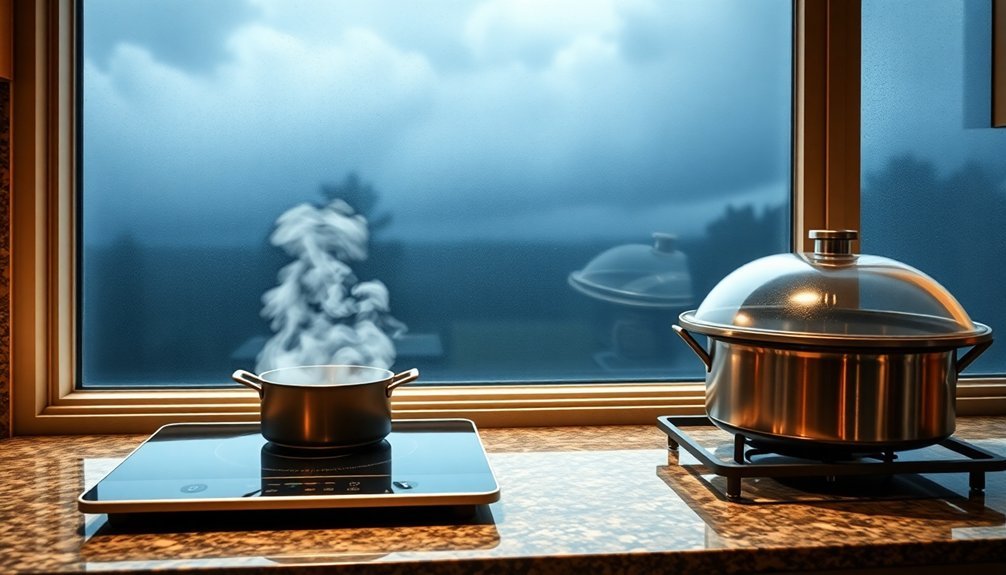



Leave a Reply